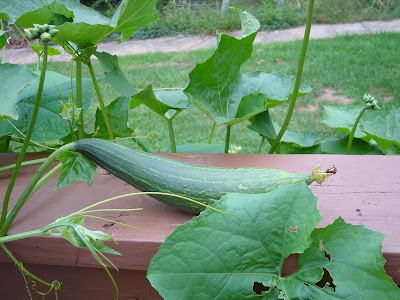



A few years ago Billy gave me some seeds of the Luffa vine. It is also spelled loofa, loofah, or lufa. A Couple of months ago I decided to plant them along the back of the deck. As you can see by the pictures they have grown by leaps and bounds. They are quite decorative and I have a few luffa growing which I hope to make into a sponge for the shower. The article below explains a little about them and I just thought it might be interesting to some of my "many" readers. If I am successful, I will be giving lufa sponges for Christmas gifts. Ha! Ha!
Loofah Article:
Quite a few people were interested in my recent harvest of Luffa shower sponges. I thought I�d explain a bit more about the plant and the process of growing it. Luffa aegyptiaca Mill. or as it is commonly called, the Loofah, is a vegetable native to South America. It can be eaten when it is smaller. I have stir fried them but only up to a size of about 4 inches. After that they become tough like an over ripe squash. Left to fully mature each fruit produces an excellent sponge. Seeds for this plant are readily available through vegetable catalogs and you’ll only have to buy seeds your first year- one mature Luffa sponge will produce at least 30 seeds. Some will produce many more.
Frost kills the plant and it needs 4 to 5 months of growth to produce sponges. Here in North Carolina I can plant seeds directly in the ground near the date of the last frost and then harvest a modest number of sponges later in autumn. If I wanted a better yield or if I lived further north I would start them indoors several weeks, maybe even a month before the date of the last frost and transplant them outdoors after frost danger has passed. Planting them on the sunny, southern side of your property will help. They are natural climbers and are happiest running up the sides of a trellis or even the outer walls of your home. I sprinkle a few seeds near, but not in front of, one of my south facing gutter downspouts. When the plant sprouts it climbs up the downspout and along my gutters. It doesn’t impede the flow of water and in the fall when the plant dies I easily pull it off of my home. The large Luffa leaves help to shade the hottest side of my house in the summer. I am certain they could be grown just as well on a large trellis. They can get quite long. I�ve grown vines that exceeded 15 feet in length.
Sometimes Luffas left to fully mature and turn brown or Luffas that ripen lying on the ground will have brown splotches of color throughout the sponge. For some people this isn’t a problem. Others however do not like bathing with something that is several different shades of rust. After I remove the outer skin and squeeze out the pulp and seeds from inside the Luffa, I often soak them in a weak solution of bleach and warm water for about 5 minutes. This is especially true of the Luffa sponges I give as gifts. The process usually lightens the color and gets rid of dark brown spots. After doing so I let them dry thoroughly by hanging them up or placing them on a drying rack.� It is also possible to dye the Luffas if you think you’d like bathing with a pink sponge.
I highly suggest you try growing Luffa sponges; even those of you in Northern climates with shorter growing seasons. Each morning as I start my day, I am reminded of my commitment to becoming more self-sufficient when I shower using a sponge I grew myself.

